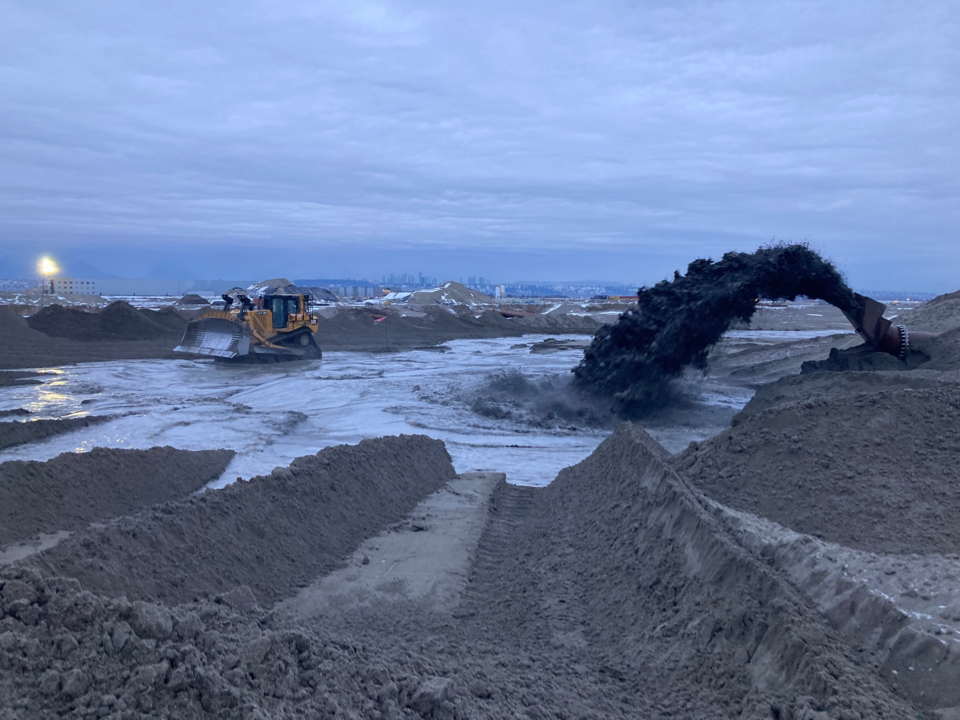If you notice some activity way off the West Dike Trail this weekend and next week, don’t raise the alarm, it’s not pirates smuggling contraband ashore.
It’s actually a very calculated experiment being conducted by conservation non-profit Ducks Unlimited Canada (DUC), which has arranged for almost 13,000 cubic metres of sediment to be pumped onto the Sturgeon Bank tidal marsh, off Richmond’s west coast.
The Sturgeon Bank Sediment Enhancement Pilot Project, as it’s called, will involve sediment – which was already scheduled to be dredged – being pumped via a temporary, one-kilometre, pipeline from the Steveston north jetty across to the target mudflat area.
The ultimate goal for DUC is to build marsh resilience and support coastal flood protection in Richmond by placing sediment on the tidal flats to enhance natural processes that have been altered by human interventions over the last 100 years.
Crews will be re-purposing sediment dredged from the Fraser River and placing it in key areas on the bank to restore valuable wild Pacific salmon habitat: marshes, eelgrass meadows, mudflats, and sand flats, which support many different fish and wildlife species.
It’s all going to start on Sunday night, when the sediment delivery pipeline will be put in place, followed on Monday evening by the first scheduled pumping.
“We’re trying to mimic the natural delivery of sediment to Sturgeon Bank,” Eric Balke, a senior restoration biologist with DUC, told the Richmond News.
“The dredge vessel from Fraser River Pile and Dredge will pick up a load of sediment, motor over to the jetty, where they will hook up to the pipeline to then pump a slurry of water and sediment out to the marsh.”
Pumping should last for three or four nights
Balke said the plan is for the pumping to go for about three or four nights, depending on the success of the operation, which has never been done before.
Balke said that, since the 1980s, about 160 hectares of tidal marsh has been lost in the area; that’s about 40 times the size of BC Place Stadium.
“Until fairly recently, no one realized it was dying off. In 2016, I became aware during my masters research,” explained Balke.
“There’s no smoking gun as to why it happened. It’s not clear.”
Balke said it could be one of a number of forces responsible for the tidal marsh recession - or a combination of them all.
He said the four “most likely culprits” are:
Sediment deficit - due to river maintenance, such as dredging;
Increased salinity from water being diverted away from Sturgeon Bank;
Sea level rise from climate change, resulting in the “delta slowly sinking under its own weight;”
Snow geese and Canada geese eating the tidal marsh vegetation.
The operation itself, Balke said, is “all very innovative, no one has really done this before.”
“As we go, we may need to adapt the plan. Most of the (pumping) windows are at night, due to the tides.”
As for the noise levels during the pumping, Balke said it’s unlikely people will hear much.
“It’s going to be quite far away and the dredge vessel is going to be behind the jetty.”
And for gauging the success of the project, Balke said, again, it’s all very much up in the air.
“To be frank, we don’t have 100 per cent idea how the ecosystem will respond. But that’s the whole point of this project,” he added.
“Something needs to be done, though. We want to find out how it will react and analyze the results, so we can use the research in other places.
“We suspect that five to 10 years of this kind of work may be needed to fully learn. We’re not trying to shock the ecosystem into doing something, we’re spreading (the sediment) out and letting the tides do the rest.”
The project is one of three Fraser River Estuary Salmon Habitat (FRESH) Restoration Projects led by DUC, in partnership with Raincoast Conservation Foundation, Tsawwassen First Nation, and the Lower Fraser Fisheries Alliance.
These projects are funded by the BC Salmon Restoration and Innovation Fund, with additional funding from Tsawwassen First Nation and the Vancouver Fraser Port Authority.



